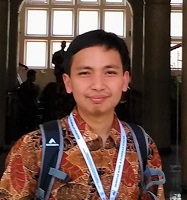Biography
Name: Dr. Eka Cahya Prima, S.Pd., M.T.
Profession: Associate Professor/Head of Study Program
Date of Birth: June 26th, 1990
Years with Firm/Entity: 7 years Nationality: Indonesia
Membership of Professional Societies:
- Indonesian Society of Science Educators (Perhimpunan Pendidik IPA Indonesia) 2015 – now
- Australasian Science Education Research Association (2018-2019)
- Materials Research Society of Indonesia 2014-Now
Researcher ID:
- Web of Science https://publons.com/researcher/2398332/dr-eka-cahya-prima-spd-mt/
- Scopus https://www.scopus.com/authid/detail.uri?authorId=56313118800
- Gscholar https://scholar.google.com/citations?user=dbF3MycAAAAJ&hl=id&oi=ao
- Sinta https://sinta.ristekbrin.go.id/authors/detail?id=5977482&view=overview
- Researchgate https://www.researchgate.net/profile/Eka-Prima-2
Detailed Tasks Assigned:
- Assigning Tridharma (three pillars) of higher education which includes:
- Education: Physics and Science Education Subjects (electricity and magnetism, mathematics for science, school science, earth and space science, and STEM education);
- Research : Learning media for science education, Arduino, Solar energy materials;
- Community service : Science education for science teacher
- Head of Study Program
- Web Master at https://ipse.upi.edu
- Journal Manager – Editor-in-Chief at Journal of Science Learning https://ejournal.upi.edu/index.php/jslearning
Key Qualifications:
Eka Cahya Prima was born in Sumedang-Indonesia, 1990. He received Doctor of Philosophy Ph.D. with Distinguished Cum Laude in Engineering Physics from Institut Teknologi Bandung in 2017, Master of Engineering M.T. with Cum Laude in Engineering Physics from the same university in 2013, Bachelor of Education S.Pd. with Cum Laude from Universitas Pendidikan Indonesia in 2011. Since 2019, he has become an associate professor of physics in the field of solar energy materials. His work has focused on fabrication, characterization, and density functional theory of third emerging solar cells. He has published several papers in most reputed publishers such as Wiley, Royal Society of Chemistry, Elsevier, Springer, and American Institute of Physics.
He lectures physics courses (Electricity and magnetism, Mathematics for science, School science, Earth and space science, and STEM education) at the International Program on Science Education, Faculty of Mathematics and Science Education, Universitas Pendidikan Indonesia since 2014. The education as his previous background, he also concerns with developing science learning media for science education. He leads the Journal of Science Learning as editor-in-chief since 2017. He obtained some best nominations in terms of the education field, such as the best outstanding lecturer in Universitas Pendidikan Indonesia 2018, the best civil servant training, Kemendikbud 2014, and medalist of national physics olympiad.
Education:
2017 Doctor of Philosophy (Distinguished Cum laude) at Department of Engineering Physics, Faculty of Industrial Engineering, Institute of Technology Bandung
2013 Master of Engineering (Cum laude) at Department of Engineering Physics, Faculty of Industrial Engineering, Institute of Technology Bandung
2011 Bachelor of Education (Cum laude) at Department of Physics Education, Faculty of Mathematics and Science Education, Universitas Pendidikan Indonesia
Employment Record:
2019 – Now Associate Professor of Physics
2017 – Now Journal Manager – Editor-in-Chief of Journal of Science Learning
2015 – Now Webmaster of https://ipse.upi.edu
2014 – 2019 Lecturer of Physics at International Program on Science Education, FPMIPA, UPI
Selected publications
- Improving photochemical properties of Ipomea pescaprae, Imperata cylindrica (L.) Beauv, and Paspalum conjugatum Berg as photosensitizers for dye sensitized solar cells, Journal of Materials Science: Materials in Electronics 25 (10), 4603-4611 , 2014
- A Light Harvesting Antenna Using Natural Extract Graminoids Coupled with Plasmonic Metal Nanoparticles for Bio‐Photovoltaic Cells, Advanced Energy Materials 4 (18), 1400470, 2014
- pH Influences on optical absorption of Anthocyanin from Black Rice as Sensitizer for Dye Sensitized Solar Cell TiO2 Nanoparticles, Materials Science Forum, 864, 154-158, 2016
- Influence of anthocyanin co-pigment on electron transport and performance in black rice dye-sensitized solar cell, Ionics, 22(9), 1687-1697, 2016
- A combined spectroscopic and TDDFT study of natural dyes extracted from fruit peels of Citrus reticulata and Musa acuminata for dye-sensitized solar cells, Spectrochimica Acta Part A: Molecular and Biomolecular Spectroscopy, 171, 112-125, 2017
- Heat Transfer Lab Kit using Temperature Sensor based ArduinoTM for Educational Purpose, Procedia Engineering, 170, 536-540, 2017
- Automatic Water Tank Filling System Controlled Using ArduinoTM Based Sensor for Home Application, Procedia Engineering, 170, 373-377, 2017
- Applying Pre and Post Role-Plays supported by Stellarium Virtual Observatory to Improve Students’ Understanding on Learning Solar System, Journal of Science Learning, 1(1), 1-7, 2017
- Donor-Modified Anthocyanin Dye-Sensitized Solar Cell with TiO2 Nanoparticles: Density Functional Theory Investigation, Materials Science Forum, 889, 178-183, 2017
- Using Physics Education Technology as Virtual Laboratory in Learning Waves and Sounds, Journal of Science Learning 1, 116-121, 2018
- Learning solar system using PhET simulation to improve students’ understanding and motivation. Journal of Science Learning 1, 60-70, 2018
- A Combined Spectroscopic and TDDFT Study of Single-Double Anthocyanins for Application in Dye-Sensitized Solar Cell. New Journal of Chemistry 42 (14), 11616-11628, 2018
- Learning Electricity using Arduino-Android based Game to Improve STEM Literacy. Journal of Science Learning 1 (3), 77-94, 2018
- Heat and temperature experiment designs to support students’ conception on nature of science, Journal of Technology and Science Education 8 (4), 453-472, 2018.
- Etching process optimization of non-vacuum fabricated Cu 2 ZnSnS 4 solar cell, Journal of Materials Science: Materials in Electronics, 31, 3674–3680, 2020
- All-Solution-Non-Vacuum Fabrication Process of CZTS Solar Cell using ZTO as Non-Toxic Buffer Layer, International Journal of Nanoelectronics and Materials 13 (2), 307-313, 2020
- Solution-processed pure Cu2ZnSnS4/CdS thin film solar cell with 7.5% efficiency. Optical Materials, 114, 110947, 2021

